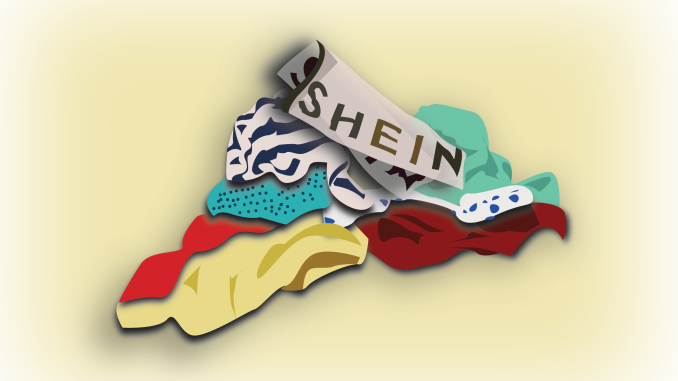
ALLYSON THARP // THE TEMPLE NEWS
Corporate retailers such as Shein, Zara and H&M use cheap production, known as fast fashion, to keep up with rapidly changing fashion trends. While its popularity and affordability have grown among college students, fast fashion is bad for both the environment and society.
It’s easy to fall victim to microtrends, as fashion is only popular for a short time and constantly promoted by celebrities and social media influencers. Young adults now over-consume fast fashion by buying clothes en masse, thus businesses thrive.
More than two in five college students buy clothes for events that they will probably only wear once, Forbes reported. Due to these microtrends, consumers say they are addicted to fast fashion and college students prefer to spend less on cheap clothes.
Students should pause to recognize the impacts of fast fashion overconsumption and transition to alternatives such as saving and reusing before quickly shopping for clothing to follow the latest trend. Fast fashion is not worth sacrificing the environment and the well-being of workers.
The average consumer now buys 60 percent more clothes than they did 15 years ago, and each garment only lasts half as long, according to the United Nations Environment Program. The clothes thrown away by consumers end up in landfills, a major source of pollution for the environment. Fast fashion manufacturers often don’t follow their limited regulations because they aren’t closely monitored, leading to poor working conditions such as low wages, long hours, unsafe conditions, and abuse.
Although college students are the biggest consumers of fast fashion, they are not entirely to blame for the environmental and social impacts. Students are targeted by companies that promote clothing through ads and trends, making their products seem like the best and most affordable option.
In 2022, the average college student working in Philadelphia will earn $3,856 per month, according to Zip Recruiter, and fast fashion is most affordable in that range.
Companies that produce fast fashion know that students don’t make a lot of money and produce clothes that match the fashion styles of college students, said Kira Eng, a sophomore in gender, sexuality and women’s studies.
“There’s a guilt about buying fast fashion, but a lot of people do it anyway because we can’t afford other things,” Eng said.
However, financially struggling students can shop for clothes at thrift stores, which are generally more affordable and environmentally friendly.
The fashion industry is the second largest consumer of water, responsible for a tenth of the water used to operate factories and industries. It uses 20 percent of global wastewater and pollutes the ocean because many offshore retail factories don’t have strict environmental regulations, according to the Princeton Student Climate Initiative.
The vast majority of clothing produced is made from cotton, which is a big contributor to excessive water use, said Kolson Schlosser, a professor of geography and urban studies.
“Agriculture and growing commodities like cotton always have a tremendous environmental impact on soil fertility, on water quality, on water use, because cotton really uses a lot of water.”
Beyond its environmental impacts, fast fashion negatively affects the people who produce it. Many of the retailers are located outside the US and use forced, child, and underpaid labor to produce clothing cheaply and quickly. Fast-track production is prioritized over the well-being of workers who are grudgingly ignored by the companies they work for.
Another social impact of current trends is the pressure to constantly have new clothes, said Fletcher Chmara-Huff, a professor of geography and urban studies.
“This whole consumption rut that we’re in is not good, this whole idea that you should have something new and more. More stuff doesn’t equal happiness,” Chmara-Huff said.
College students should turn conversations about everyday fashion and buying new pieces into discussions about sustainable fashion practices, such as buying secondhand, donating, and recycling.
“The most sustainable option is always going to be what’s in your own closet,” said Elliza O’Grady, advertising student and president of Thrift and Flop. “Before you buy a piece, think about how it would fit in your closet and how it will interact with your other pieces.”
It is important to decide if purchasing a new item of clothing is the most necessary and ethical option. If the item doesn’t work well with your other clothing, it’s important to donate or recycle it instead of throwing it away.
However, if an item of clothing doesn’t fit well or has worn out, recycling (reusing items to create a more useful item of clothing) gives clothing another life. Thrift and Flop is a club and resource on campus that teaches upcycling to rework pieces that are already in students’ closets.
There are many thrift stores that will donate their profits to nonprofits and work with other organizations. Philly Aids Thrift is a store in Philadelphia where students can save and donate their unworn clothes. Fabscrap is another resource that sells different types of fabrics that are collected secondhand so that customers can sustainably recycle their own clothing.
Today, the Office of Sustainability is hosting a Pop-up Thrift on Polett Walk, where clothing donated during last year’s residence move will be sold for less than $10.
It is important for college students to be aware of their decisions when buying new clothes and handling the pieces they do not wear, as it has a significant impact on the environment and society.
Source: news.google.com